Basic parameters
Centaurus A
( Cen A, NGC 5128, PKS 1322-427 ) 1)
Classifications
NGC 5128 galaxy type: Ep (Harris 2010)
Radio galaxy: Fanaroff-Riley class I
Unification scheme: misaligned BL Lac (Chiaberge et al. 2001)
Coordinates (nucleus)
R.A. (J2000) = 13h25m27.s6152 (201.°3650633)
Declination (J2000) = -43°01'08."805 (-43°0191125)
l" = 309.°5158743
b" = 19.°4173247
Distance (to the central regions) 2)
3.8 ± 0.1 Mpc (Harris et al. 2010); 1' ≈ 1.1 kpc (at 3.8 Mpc)
z ≈ 0.0009 (with H0 = 70 km s-1 Mpc-1)
Black hole mass 3)
(5.5 ± 3.0) x 107 Msun (Cappellari et al. 2009)
Stellar mass
~ 2 x 1011 Msun (Wang et al. 2020)
Jet power (present-day jet)
(1—2) x 1043 erg s-1 (Croston et al. 2009; Wykes et al. 2013; Neff et al. 2015a)
Age 4)
Parent massive elliptical galaxy: several Gyr (Wang et al. 2020)
Radio galaxy: ∼ 560 Myr (Wykes et al. 2013, Eilek 2014, Wykes et al. 2014)
Magnitudes
Total integrated apparent magnitude: mV = 6.20 (Dufour et al. 1979)
Dereddened integrated magnitude and colours: V0,tot = 5.87, (B-V)0 = 0.84,
(U-B)0 = 0.36 (Dufour et al. 1979)
Location
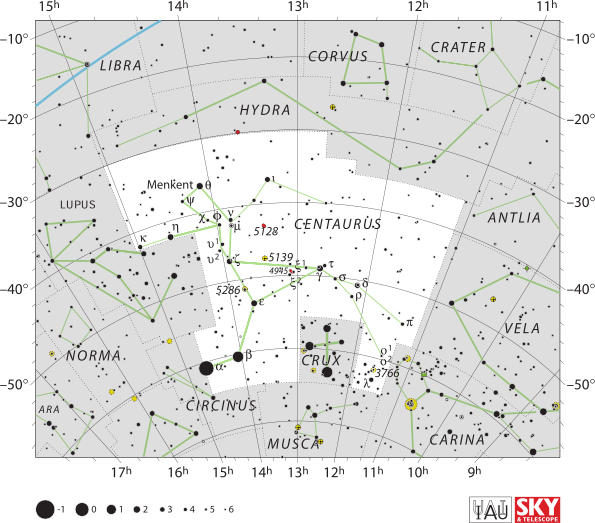 Constellation Centaurus Credit: IAU and Sky & Telescope magazine (Roger Sinnott & Rick Fienberg) |
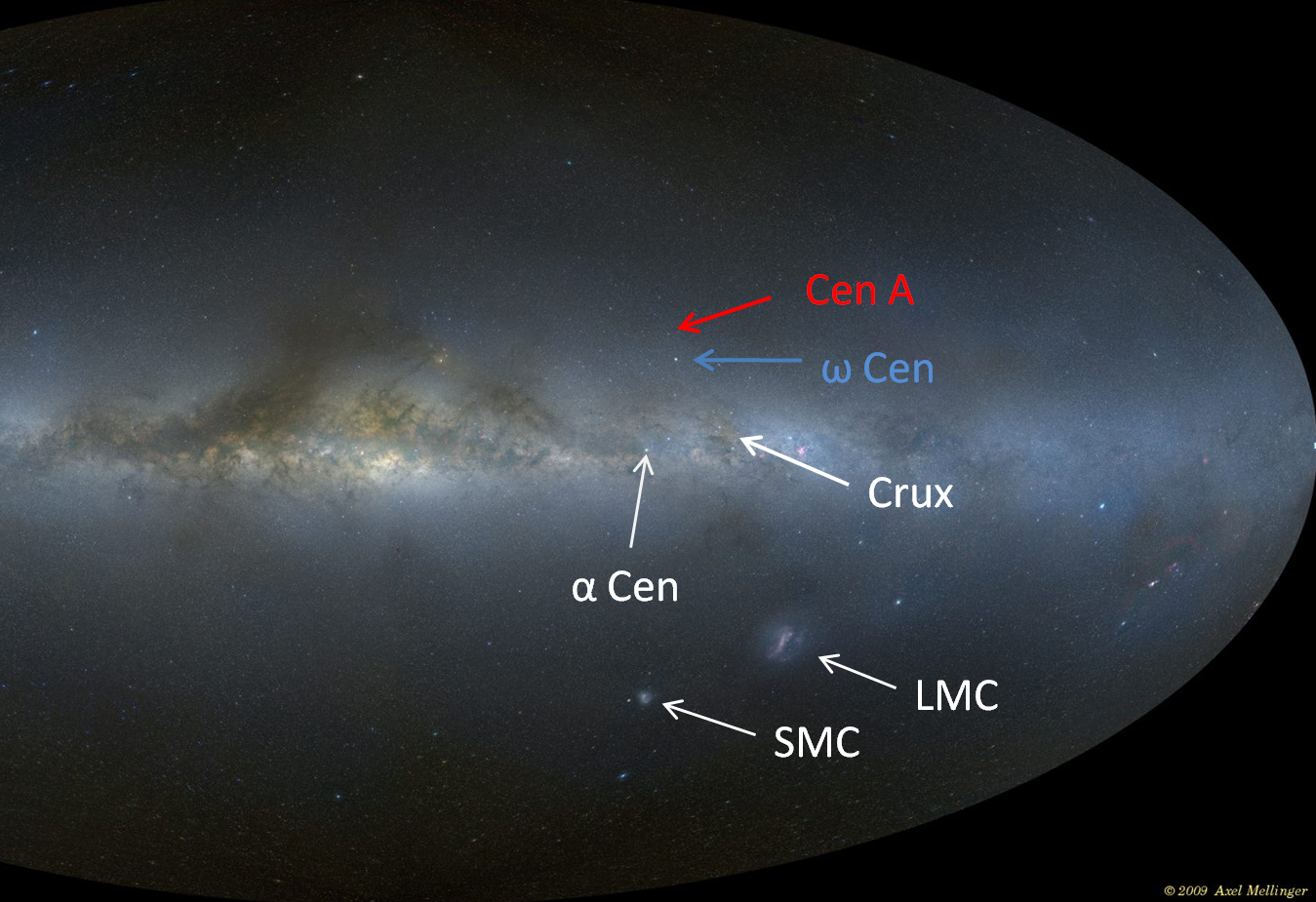 Milky Way panorama with the location of Cen A overlaid. Credit: Axel Mellinger |
Nomenclature of the (radio) structures
In order to describe the position of various structures, researchers have traditionally resorted to radio observations. The Cen A radio morphology has been thoroughly discussed by Burns et al. (1983), Junkes et al. (1993), Israel (1998), Alvarez et al. (2000), Goodger et al. (2010), Feain et al. (2011), Müller et al. (2014), Neff et al. (2015a) and McKinley et al. (2021).More recently, some of Cen A's morphology has been described at other wavelengths as well, see e.g. Hardcastle et al. (2006), Kraft et al. (2009), Croston et al. (2009), Abdo et al. 2010, Goodger et al. (2010), Neff et al. (2015b), McKinley et al. (2018).
These pages offer the following guideline:
- Centaurus A (Cen A) is the entire radio galaxy, the large-scale structure, about 9° at maximum extent, between approximately -39° and -48°, including the giant lobes (GLs) — the northern giant lobe and the southern giant lobe;
- the northern part of the northern GL contains the northern loop;
- the middle regions, or transition regions, are located between about 10' and 40' from the nucleus and include the northern middle lobe;
- the inner lobes (ILs) span about 10' end-to-end, between approximately -42°56' and -43°06', and comprise the north-east inner lobe and south-west inner lobe;
- the (main) jet extends about 4.5' (radio) and 4.1' (X-ray) to the north-east;
- the regions on the scale of the inner lobes and smaller are referred to as the central regions
- the nuclear jet is the VLBI jet

Overview over the radio structure of Centaurus A. The whole radio (and gamma-ray) emitting
region extends about 9° on the sky. Currently, with VLBI techniques, structures of the jet and the 'core' corresponding to a resolution of 0.68 x 0.41 milliarcseconds can be resoved.
Source: Wikipedia
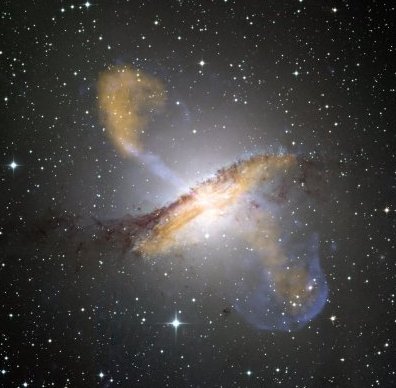
Multiwavelength composite of the central regions with
the inner lobes and the main jet to the north-east.
Credit: ESO/WFI (Optical);
MPIfR/ESO/APEX/A.Weiss et al. (Submillimetre);
NASA/CXC/CfA/R.Kraft et al. (X-ray)
Some authors refer to the GLs as the extended source or the outer lobes. The inner lobes plus the region closer to the nucleus including the main jet are also referred to as the central source or the central component. The term inner jet refers in most instances to the more central parts of the kiloparsec-scale jet (to about 2.2' from the nucleus); however, the term has also been used for the entire jet, and for the nuclear jet. What in the literature is referred to as the core is strongly dependent on the observing frequency and resolution.
Centaurus A will be one of the key targets of the Cherenkov Telescope Array (CTA). With an 8° field of view, CTA will be able to cover the giant lobes in one exposure. Moreover, CTA will have the resolving power to see sub-structures in the inner regions of the radio galaxy, see CTA Observatory — Key Targets.
Position of the nucleus
The position of the nucleus, which is hidden in the optical by the dense dust lane, was eventually determined using the Hubble Space Telescope (HST) optical WFPC2 image combined with the HST near-infrared NICMOS image and the SOFI/NTT image. The derived position is marked on the following three images which show NGC 5128 with increasing resolution (see Marconi et al. 2000 and Kainulainen et al. 2009).
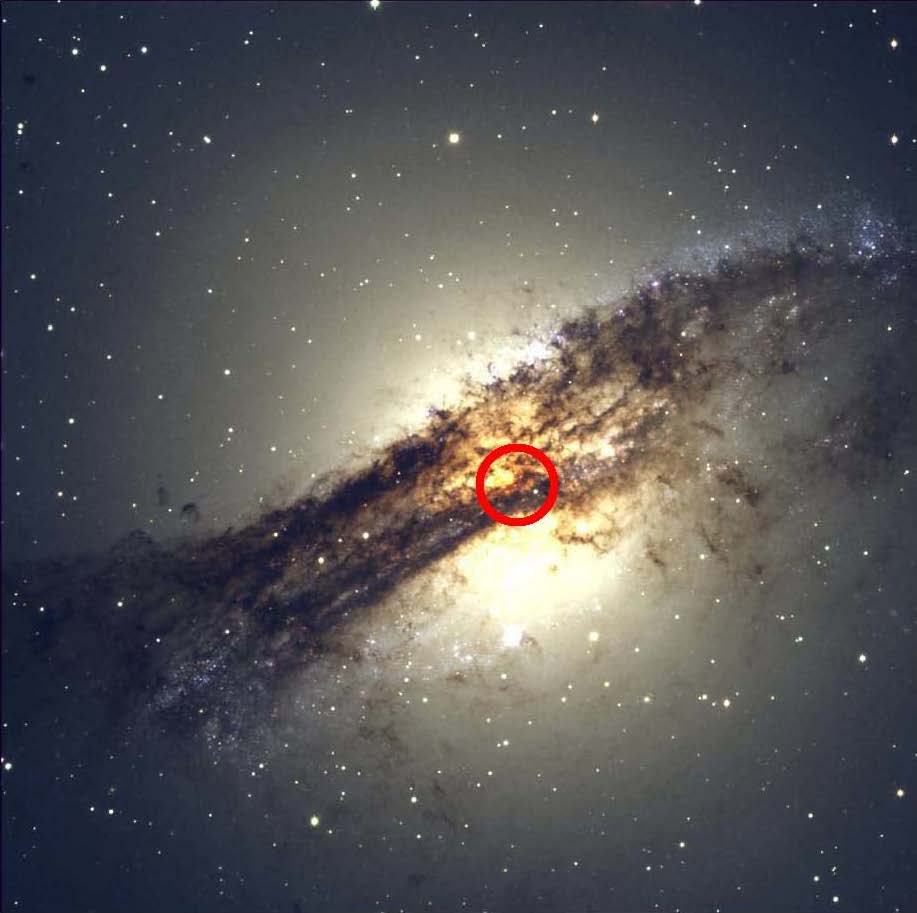
ESO: VLT — Kueyen |
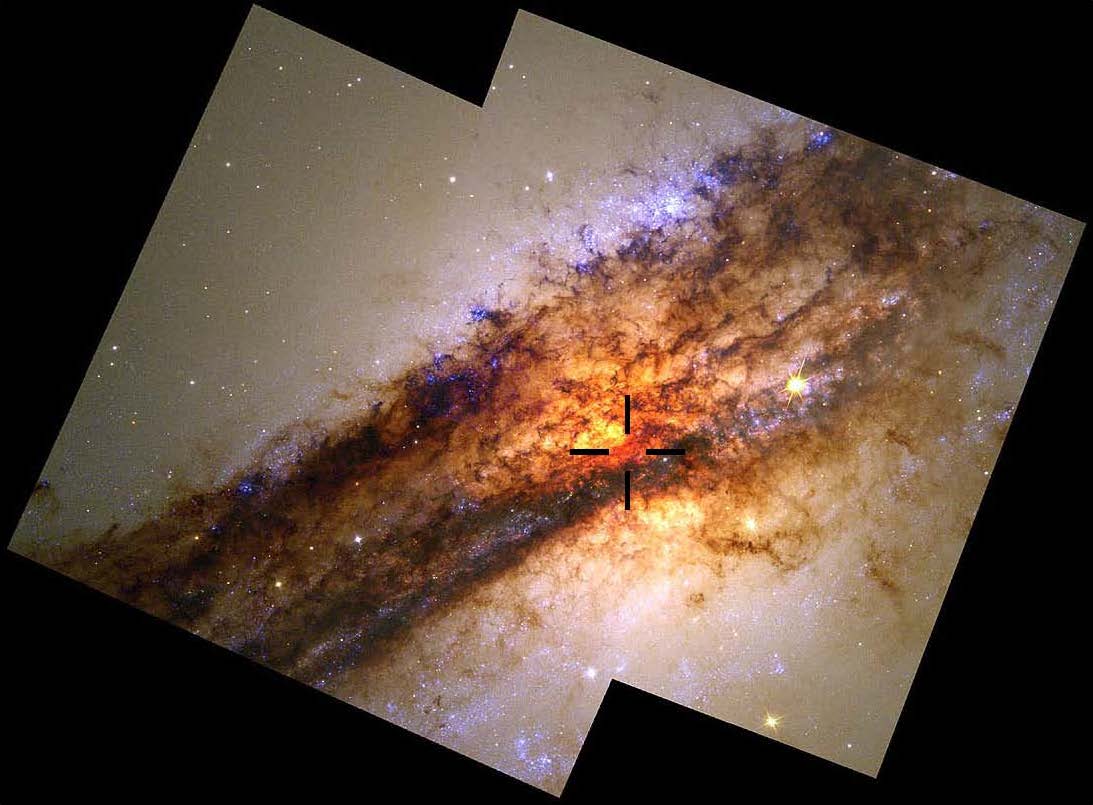
HST: WFPC2 mosaic |
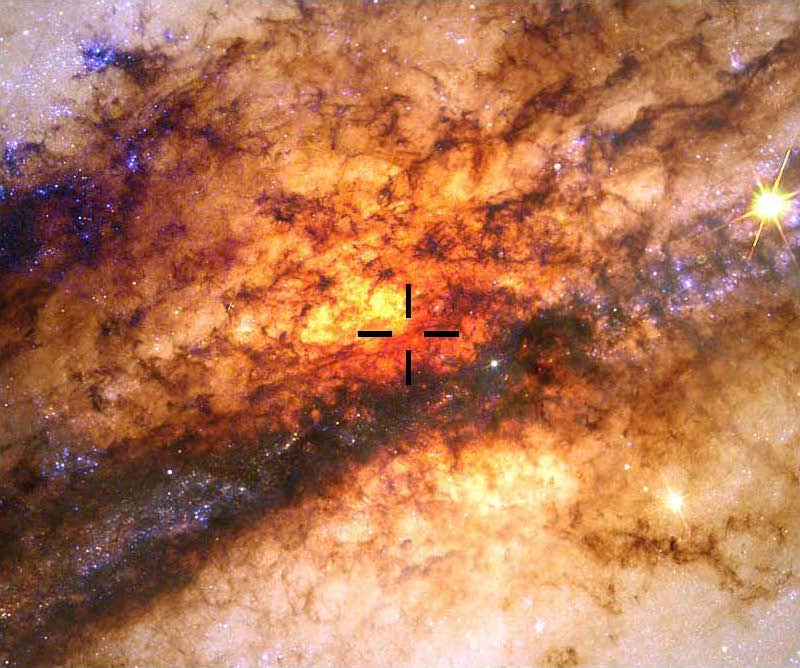
HST: WFPC2 |
Notes
- Alternative names:
Name Type Name Type ================= ======= ====================== ====== 1FGL J1325.6-4300 Gamma 1322-427 MCG -07-28-001 G 1322-428 Mills 13-4A 13223-427 MOST 1322-427 1ES 1322-427 XrayS MRC 1322-427 RadioS 1H 1323-428 XrayS MSH 13-4-02 1Jy 1322-428 NGC 5128 G 1Jy 1322-42 NRL 7 1M 1322-427 PGC 046957 G 2A 1322-427 PMN J1325-4302 RadioS 2E 1322.5-4245 PMNM 132221.3-424700 RadioS 2EG J1324-4317 PKS 1322-42 RadioS 3EG J1324-4314 PKS 1322-427 3U 1322-42 PKS 1322-428 4U 1322-42 PKS B1322-428 RadioS ARP 153 G PKS J1325-4303 RadioS AM 1322-424 G PRC C-45 G Bennett 60 RORF 1322-427 Cen A RadioS RX J132524.4-430100 Centaurus A RadioS RX J1325.5-4301 XrayS CTA 59 SGC 132233-4245.4 G Cul 1322-427 RadioS SPB216 Dunlop 482 XRS QSO 3A 2E 3038 EGRET J1326-43 G [PT56] 27 ESO 132233-4245.4 G [VDD93] 184 ESO 270-IG 009 G [VV2000b] J132528.0-430100 ESO-LV 2700090 G [VV98b] J132528.0-430100 GRO J1314-42 [CRA98] 4 H 1322-427 [M98c] 132233.0-424524 ICRF J132527.6-430108 RadioS [KWP81] 1322-42 RadioS IERS B1322-427 RadioS [A94] 35 G IRAS 13225-4245 IrS IRAS F13225-4245 IrS LGG 344:[G93] 002 G
- Distance determinations:
Currently, the most accepted distance value to the central regions is 3.8 ± 0.1 Mpc (see Harris et al. 2010).
- 5.0 Mpc (Burbidge & Burbidge 1959; assumption)
- 7.9 Mpc (Sandage & Tammann 1975; relying on H II regions, galaxy group)
- 2.4 x (100/H) Mpc (van den Bergh 1976; absolute magnitude)
- 3.3 ± 0.4 Mpc (de Vaucouleurs G. 1979; several methods including redshift)
- 3 Mpc (de Vaucouleurs G. 1980; from brightest globular cluster)
- 3—4 Mpc (Harris et al. 1984; from Globular Cluster Luminosity Function (GCLF))
- 2 ± 0.8 Mpc (Davies et al. 1984; from rotation velocity and dispersion)
- 3.2 Mpc (Harris et al. 1988; from Globular Cluster Luminosity Function (GCLF))
- 3.8 Mpc (Jacoby et al. 1988; from Planetary Nebulae Luminosity Function (PNLF))
- 3.0 Mpc (Ford et al. 1989; from Planetary Nebulae Luminosity Function (PNLF))
- 3.1 ± 0.1 Mpc (Tonry et al. 1990; from surface-brightness fluctuation)
- 3.84 ± 1.1 Mpc (Shopbell et al. 1993; from surface-brightness fluctuation)
- 3.5 ± 0.2 Mpc (Hui et al. 1993; from Planetary Nebulae Luminosity Function (PNLF); revision of Tonry et al. 1990 result)
- 3.6 ± 0.2 Mpc (Soria et al. 1996; from Tip of the Red Giant Branch (RGBT) method)
- 3.9 ± 0.3 Mpc (Harris et al. 1999; from Tip of the Red Giant Branch (RGBT) method)
- 3.84 ± 0.35 Mpc (Rejkuba 2004; from Tip of the Red Giant Branch (RGBT) method and the Mira period-luminosity relation; used for the first time outside the local group of galaxies)
- 3.42 ± 0.18 (random) ± 0.25 (systematic) Mpc (Ferrarese 2007; based on Cepheid variables observed with HST)
- 3.8 ± 0.1 Mpc (Harris et al. 2010; evaluation of existing methods and their uncertainties)
An overview of distance determinations is also available in the NASA/IPAC Extragalactic Database of Distances.From radial velocity measurements which give an average of 547 ± 5 km s-1, a redshift z of 0.00183 ± 0.00002 is derived (Graham 1978). While frequenty used, this would place Cen A at a distance of 7.7 Mpc! This redshift differs significantly from the calculated z value determined by other means. The discrepancy is due to the proximity of Cen A and a significant superposition of the proper motion of the galaxy within its group and its cosmological velocity.
Other velocity measurements:
538 km s-1 (Wilkinson et al. 1986; from spectroscopy, absorption line spectra)
541 ± 7 km s-1 (Hui et al. 1995; from planetary nebulae)
546 ± 7 km s-1 (Woodley et al. 2007; from globular clusters)
539 km s-1 (Walsh et al. 2015; from planetary nebulae)
Regarding the large radio galaxy scale, Wykes et al. (2015b) remark that "The distance to the giant lobes is not well constrained; HI absorption against the south-west inner lobe and higher radio linear polarisation of the northern inner lobe could hint at the northern giant lobe in front (van Gorkom et al. 1990; Junkes et al. 1993). The absence of a depolarisation signal in the 1.4 and 5 GHz radio continuum data at the position of the dwarf irregular galaxy ESO 324—G024 (which is in projection on the northern giant lobe and at approximately the same distance as Centaurus A's core) also favours the northern giant lobe being in front (Johnson et al. 2015). In turn, the southern giant lobe is both larger in projection and brighter (e.g. Alvarez et al. 2010; Abdo et al. 2010; Feain et al. 2011), which would suggest the southern giant lobe being closer if disregarding different physical conditions in the lobes."
- Black hole mass estimates:
Currently, the most accepted black hole mass is (5.5 ± 3.0) x 107 Msun (Cappellari et al. 2009).
- ∼ 1 x 109 Msun (Marconi et al. 2000; from photometric structure and BH growth models)
- (2 +3.0/-1.4) x 108 Msun (Marconi et al. 2001; from gas kinematics; for a disc inclination > 15°)
- ∼ 2.4 x 108 Msun (Silge et al. 2005; from stellar kinematics, for an edge-on model)
- (1.1 ± 0.1) x 108 Msun (Marconi et al. 2006; for a disc inclination of 25°)
- (6.5 ± 0.7) x 107 Msun (Marconi et al. 2006; for a disc inclination of 35°)
- (6.1 +0.6/-0.8) x 107 Msun (Häring-Neumayer et al. 2006)
- (8.25 +2.25/-4.25) x 107 Msun (Krajnovic et al. 2007; from Paschen beta kinematics, for inclination of 25°)
- ∼ 4.5 x 107 Msun (Neumayer et al. 2007)
- (5.5 ± 3.0) x 107 Msun (Cappellari et al. 2009)
A review paper on the black hole mass comparing the different techniques and results is by Neumayer (2010).
Note by S. Wykes: "The existence of a binary black hole has been disfavoured based on stellar and gas kinematics, which show no sign of disturbance by a second black hole, and on the fact that there is only a single radio- and K-band source at the nucleus (N. Neumayer, private communication)."
- Age estimates:
Age of the parent elliptical galaxy:
-
We can only measure the age of stars and globular clusters; it is more difficult to determine how old the elliptical galaxy is itself.
Rejkuba et al. (2011) measured stellar age distribution, finding that bulk of the stars in this galaxy has formed 12 ± 1 Gyr ago in an intense and short starburst event. According to that, > 80 per cent of the mass of the galaxy would have formed by approximately 11 Gyr ago. However, we can't be certain that this is the elliptical we see today. Are these stars otherwise coming from mergers of several galaxies that assembled hierarchically to build the elliptical we see today? (See Section Stellar content for more details.)
Radiative age of the radio galaxy:
- ∼ 30 Myr (Hardcastle et al. 2009; based on synchrotron ageing fitting)
- ≤ 80 Myr (Yang et al. 2012; reasoning that ages significantly higher are not consistent with the observations of gamma-ray inverse-Compton emission)
Dynamical age (true age, physical age) of the radio galaxy:
- ∼ 560 Myr (Wykes et al. 2013; buoyancy arguments, Wykes et al. 2014)
- ∼ 500 Myr — 1.5 Gyr (Eilek 2014; relying on dynamical models of the growth of the giant lobes)
- Jet inclination estimates:
- 73° ± 3° (Graham 1979; relying on H II regions)
- 72° ± 3° (Dufour et al. 1979; relying on disc of young stars and H II regions)
- 61° ± 5° (Skibo et al. 1994; based on OSSE measurements and model)
- 60° — 77° (Jones et al. 1996; from jet/counterjet radio brightness ratio; parsec scale)
- 50° — 80° (Tingay et al. 1998b; from jet/counterjet radio brightness ratio; parsec scale)
- ≤ 50°, preferably ~ 15° (Hardcastle et al. 2003; from jet/counterjet radio brightness ratio and component speeds; kiloparsec scale)
- 12° — 45° (Müller et al. 2014; from jet/counterjet radio brightness ratio and component speeds; parsec scale)
- ~ 50° (Wykes et al. 2019; results from the 1D fluid model of the jet consistent with inclination of 50°; kiloparsec scale)